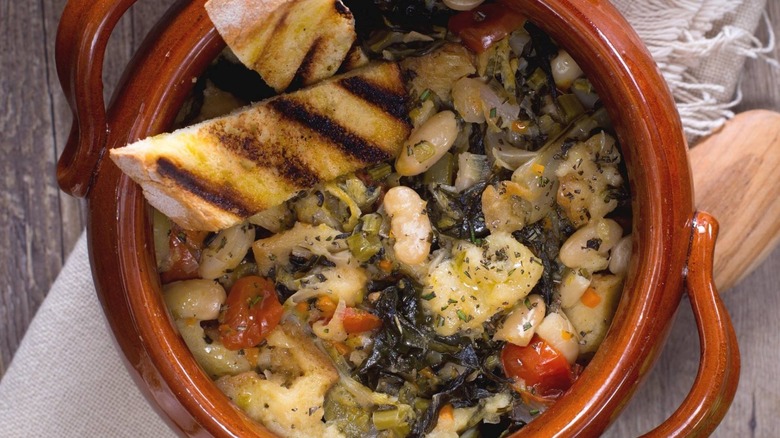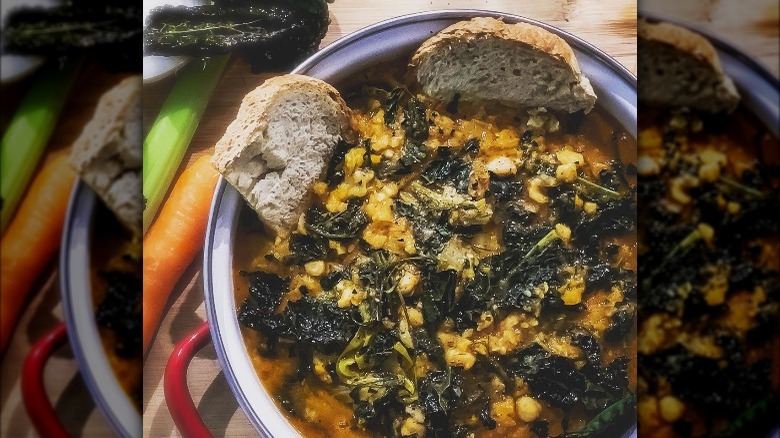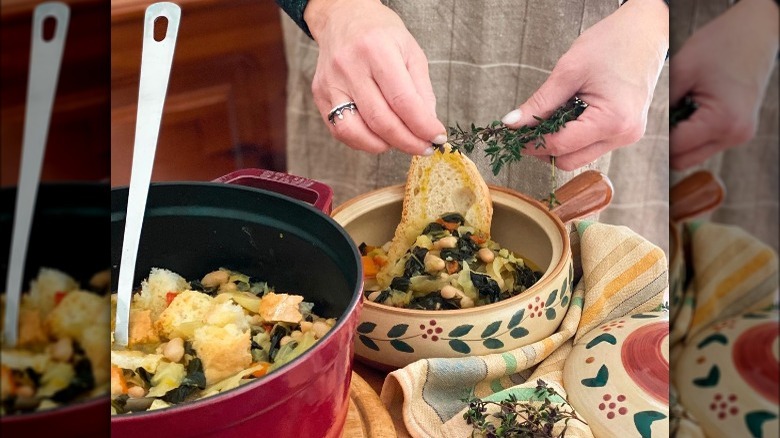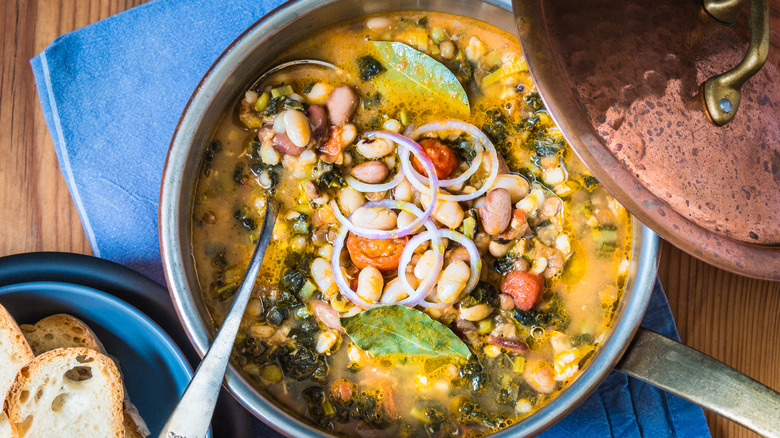What Is Ribollita And How Is It Made?
Ribollita is one of the most warming, satisfying dishes imaginable, especially perfect for a blustery, cold winter's night. It's a rich, thick medley of soup, stew, and porridge all in one, starring a blend of beans, winter vegetables, and the star of the show (an unexpected ingredient to incorporate into a soup instead of on the side of it): bread!
What essentially began as a reheated minestrone, according to Serious Eats, ribollita is a rustic Italian dish with a celebrated tradition. It's prime for customization — toss in whatever greens, beans, or veggies you have on hand. You could also add cheeses, starches, and grains and use your choice of fresh or stale bread. It's all up to you. Fortunately, it's not a dish you need to baby, as it's pretty much impossible to overcook. Here's what to know about ribollita, the epitome of comfort food that also happens to be popular and affordable for a crowd.
History of ribollita
As noted by Serious Eats, ribollita means reboiled in Italian, which is a name that was coined because the dish was originally the result of stale bread and leftover vegetable soup. The peasant dish has been around since the Middle Ages, per Italy Magazine, and could have gained popularity because Catholics generally abstained from eating animal products on Fridays — making a combination of beans, vegetables, and bread the ideal thing to eat.
According to Eataly, ribollita is a shining example of cucina povera, a rural style of Italian cooking defined by creativity and resourcefulness with the available, humble ingredients on hand. By incorporating stale bread as a thickener and using economical ingredients such as greens and beans, Tuscan cooks were able to prepare this rich, hearty dish to satisfy and sustain the entire family without wasting any food. In fact, some of the most beloved Italian dishes come from la cucina povera in Tuscany, where people have historically eaten a lot of bread and found ways to turn hard, dry loaves into iconic meals. These include not only ribollita, but also bruschetta, panzanella, and pappa al pomodoro.
How is it made?
Per, Food & Wine, one of the most important components of ribollita is soffrito, also known as mirepoix, as it provides a base of flavors that infuses the final product. This mixture of onion, celery, and carrot is cooked in extra-virgin olive oil until very soft, followed by more vegetables, beans, and bread. According to Italy Magazine, each cook adds different ingredients in a different order. Generally, the recipe includes cavolo nero (Tuscan kale), cannellini beans, and lots of water or vegetable stock. Some cooks add tomatoes, potatoes, cabbage, zucchini, and herbs such as thyme. When the vegetables are tender and the beans have lended their starchiness, the bread is added in large pieces and simmered until it softens and thickens the soup.
The final product is very savory, nourishing, and dense — Eataly even states that proper ribollita should be eaten with a fork instead of a spoon due to its thick consistency. One of the highlights of ribollita is its textural differentiation: With so many ingredients, no two bites are the same. While this dish showcases hardy vegetables and creamy beans, some recipes call for the addition of Parmesan cheese and a drizzle of high-quality olive oil on each bowl to add a touch of savoriness and spice. As with many hearty dishes, soups, and comfort foods, ribollita only gets better as it sits.
Nutritional information about ribollita
It likely comes as no surprise that ribollita is quite healthful, bursting with dark greens, protein-rich beans, and tons of wintry vegetables. Though it's vegan, it's unsuitable for gluten-free dieters. EatingWell, however, provides a breadless version that's thickened with the beans, which means ribollita is an adaptable dish for a variety of dietary needs. Per Healthline, white beans not only provide scores of protein and fiber, but also significant amounts of the minerals your body needs daily, including folate and iron. Plus, people who live in blue zones eat beans daily, leading experts to believe that a bean-heavy diet is associated with longevity.
Vegetables also add substantially to ribollita's nutritional profile. Kale, one of the best known superfoods, is thought to help prevent cancer, diabetes, and heart disease due to its high amounts of antioxidants, fiber, and vitamins, according to Medical News Today. The benefits of the beans and greens in ribollita can be boosted even further with the addition of other vegetables. No matter how you customize it, ribollita is a rustic form of sustenance that satisfies both stomach and soul.



